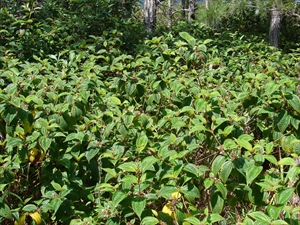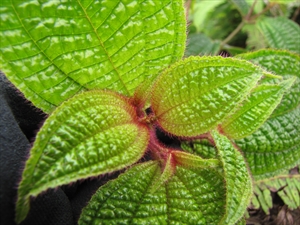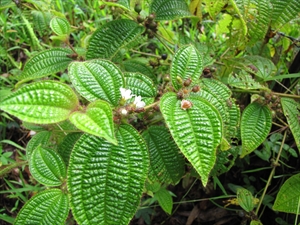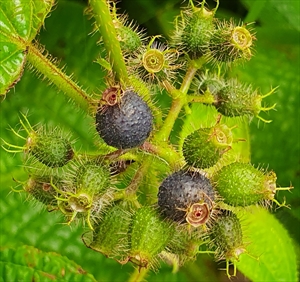- Widespread. Asia, East Africa, South and Southeast Asia, North, South and Central America, Caribbean, Oceania. In many Pacific islands.
- Important invasive perennial bush: high seed production, rapid growth, tolerance to many disturbed and undisturbed environments. A threat to Pacific islands, forming dense thickets, smothering plantations, pastures, native vegetation, including forests.
- Stems, up to 1m, round, hairy. Leaves, 5-18 cm long, dark green, paired along stems, five distinct veins and cross-veins, more hairy below, on short leaf stalk. Flowers, clusters in leaf forks and at branch tips, on short stalks, with five white or pink petals, and claw-like stamens. Fruits, round, purplish-black berries with about 100 brown seeds.
- Spread: seed by birds and floodwaters, vehicles, pigs, on clothing, trade in ornamentals.
- Biosecurity: high risk of introduction. In Australia, 'restricted invasive plant': do not release into environment, give away or sell. Among 100 of World's Worst Invasive Alien Species (IUCN, 2020). Can be bought via internet.
- Biocontrol: Success with Liothrips urichi (Fiji); recently (Hawaii), Lius peisodon, for shaded areas; Colletotrichum gloeosporiode f.sp. clidemiae, for drier parts.
- Cultural control: pull-out seedling, dig out shrubs, cultivate land; control feral pigs; vehicle hygiene to remove seed.
- Chemical control: in Australia: glyphosate (and Fiji); metsulfuron-methyl; fluroxypyr.
Pacific Pests, Pathogens and Weeds - Online edition
Pacific Pests, Pathogens, Weeds & Pesticides
Koster's curse (448)
Koster's curse; it is also known as soapbush.
Clidemia hirta. It was known previously as Clidemia elegans, Melastoma elegans. It is a member of the Melastomataceae.
AUTHORS Grahame Jackson & Aradhana Deesh
Information from Clidemia hirta (L.) D. Don (2016) Weeds of Australia. Biosecurity Queensland edition. Queensland Government. (https://keyserver.lucidcentral.org/weeds/data/media/Html/clidemia_hirta.htm); and CABI (2019) Clidemia hirta (Koster's curse). Invasive Species Compendium. (https://www.cabi.org/isc/datasheet/13934); and Clidemia hirta (2019) Wikipedia. (https://en.wikipedia.org/wiki/Clidemia_hirta); and Koster's curse (Clidemia hirta) (2018) NSW Weedside. Department of Primary Industries. (https://weeds.dpi.nsw.gov.au/Weeds/Kosterscurse); and Clidemia hirta (2013) Bugwood wiki. (https://wiki.bugwood.org/Clidemia_hirta); and Waterhouse & DF, Norris KR (1987) Clidemia hirta (Linnaeus) D. Don Biological Control Pacific Prospects. Inkata Press, Melbourne. Photos 1-6 Forest & Kim Starr. Starr Environmental, Flickr; and from CHAH (2011) Clidemia hirta (L.) D.Don. WeedsAustralia - Profiles. Department of Sustainability, Environment, Water, Population and Communitie. (https://profiles.ala.org.au/opus/weeds-australia/profile/Clidemia%20hirta).
Produced with support from the Australian Centre for International Agricultural Research under project HORT/2016/185: Responding to emerging pest and disease threats to horticulture in the Pacific islands, implemented by the University of Queensland, in association with the Pacific Community and Koronivia Research Station, Ministry of Agriculture, Fiji.










